PsyCore Pitch Deck
http://www.slideshare.net/PitchDeckCoach/the-ultimate-pitch-deck-template-by-pitchdeckcoach http://www.slideshare.net/JasonBulsa/psycore
↥
How Much Content
↥
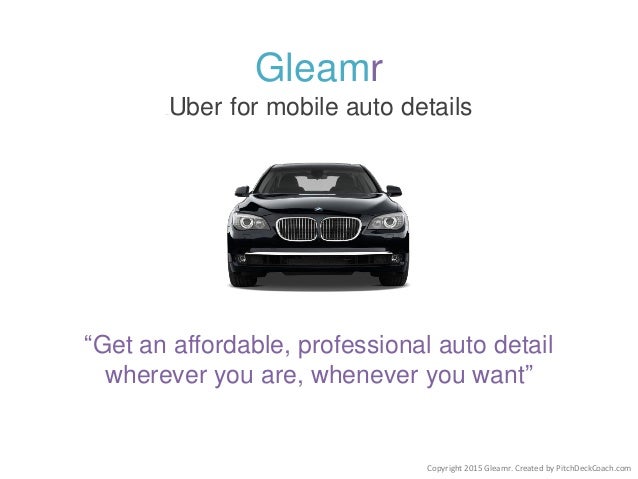
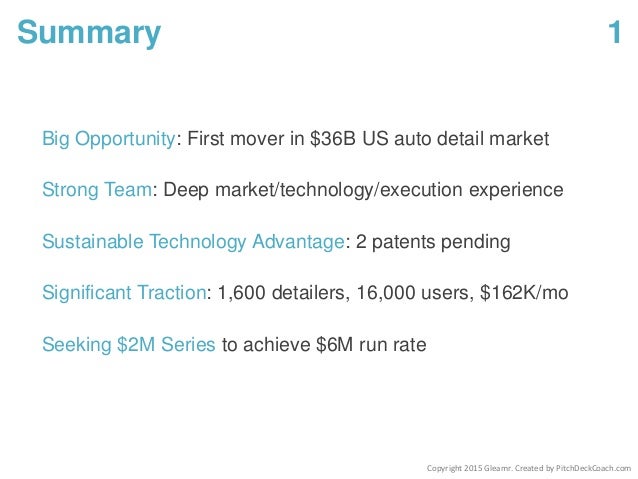
↥
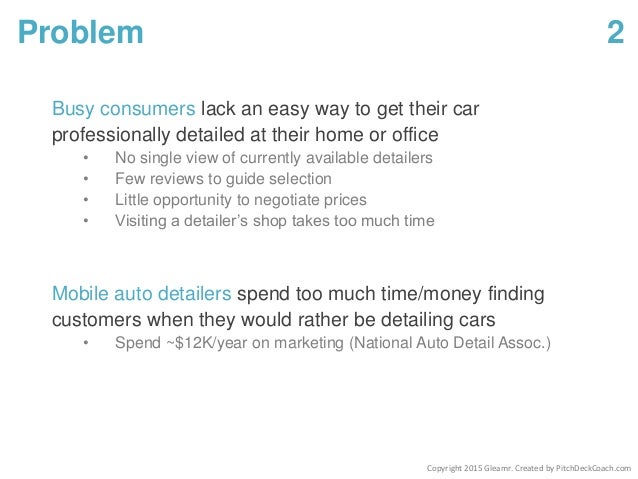
↥
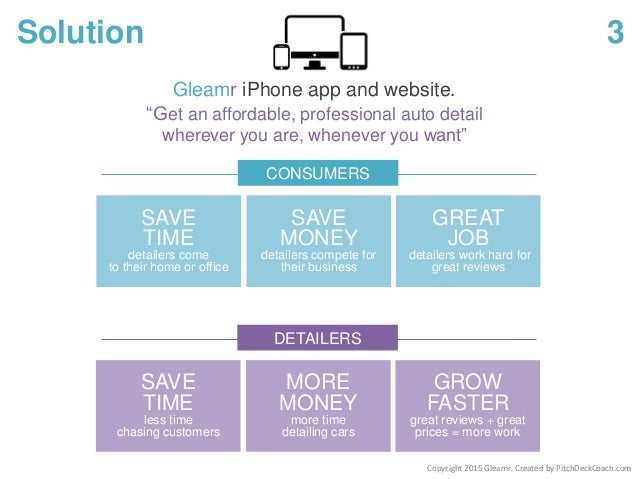
↥
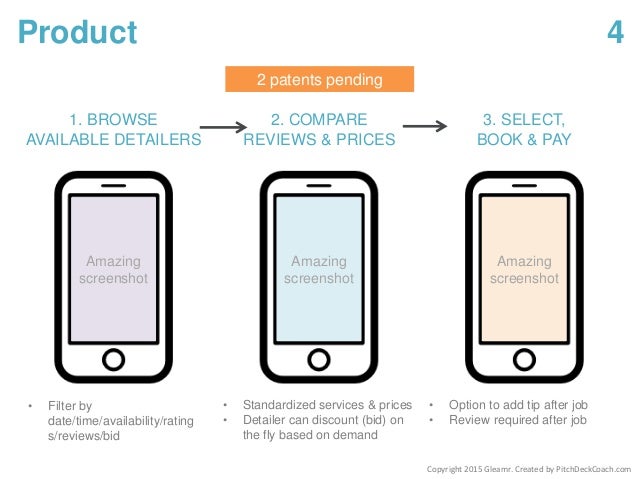
↥
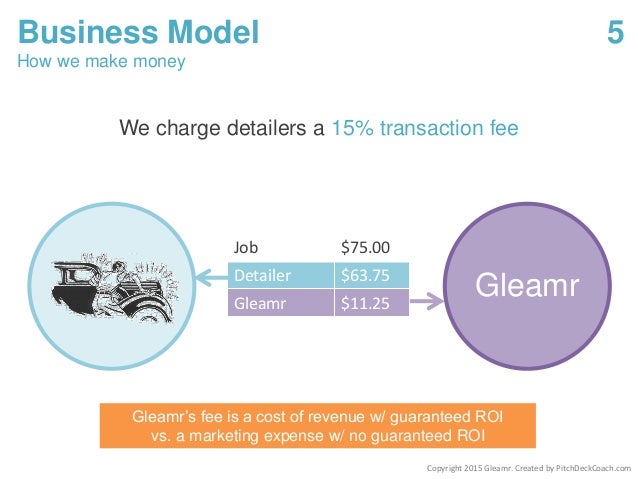
↥

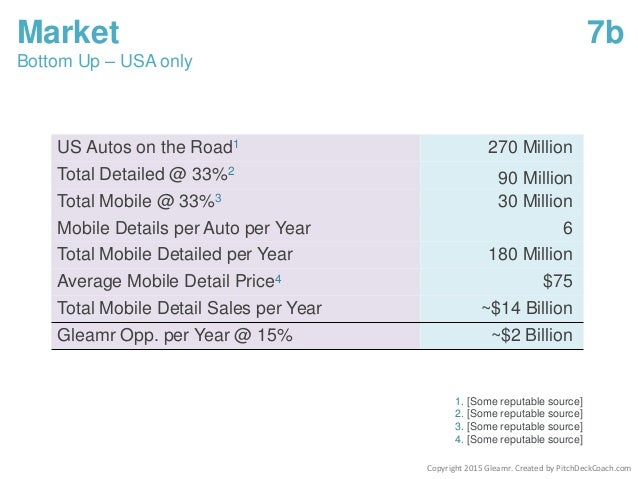
↥
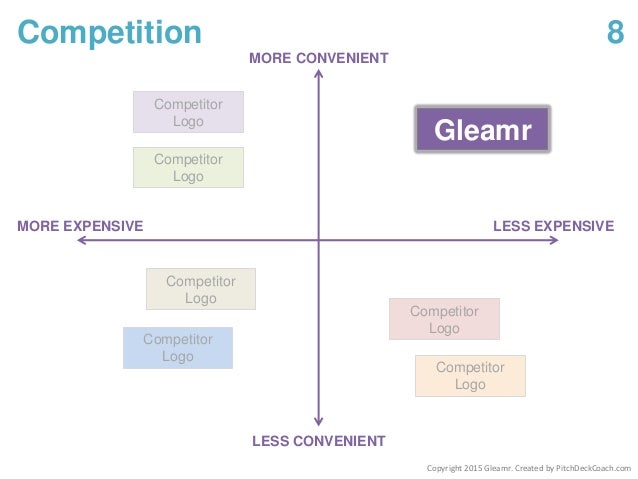
↥
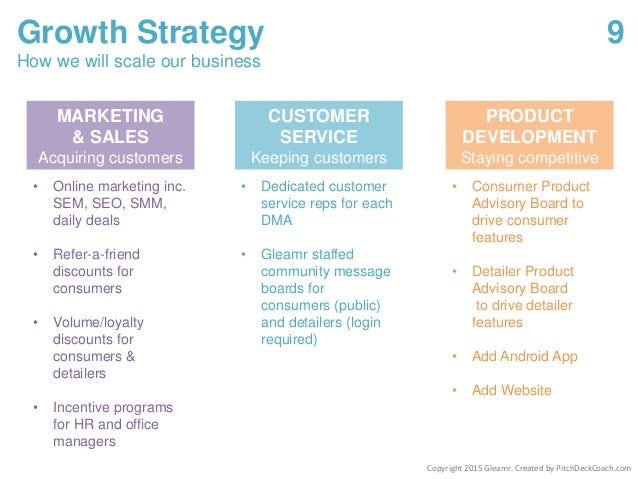
↥
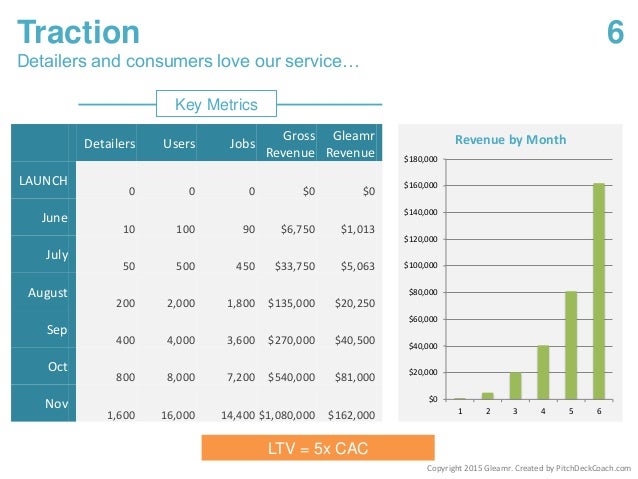
↥
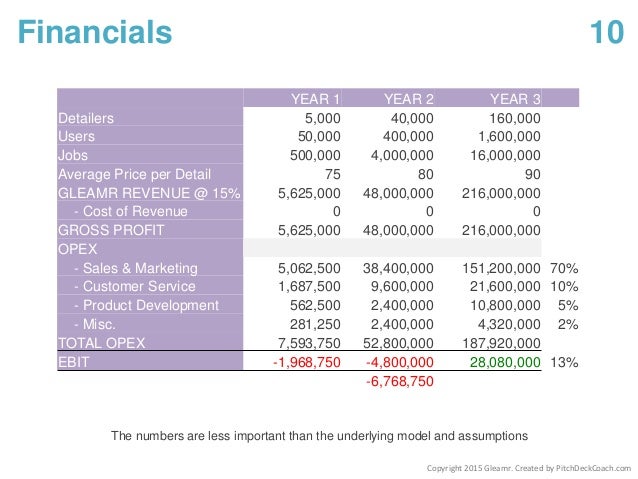
↥
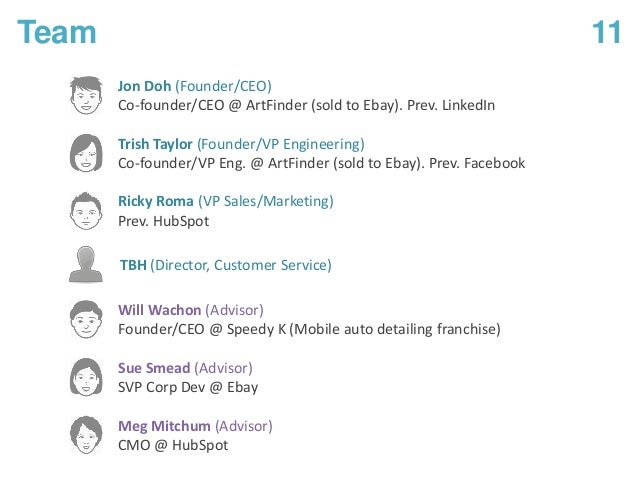
↥
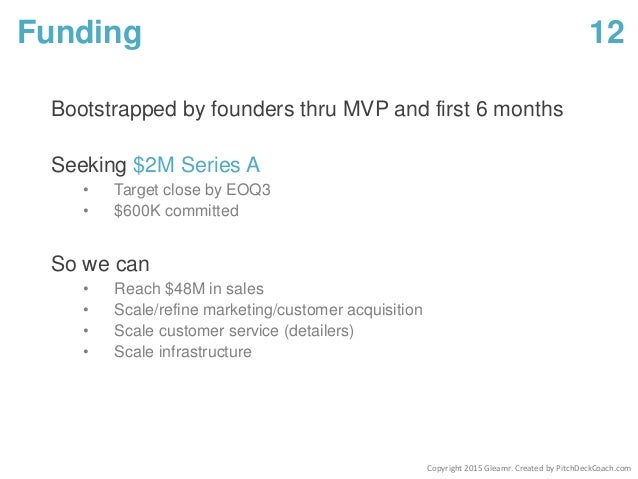
↥
↥
- Cover: Announce your big idea. The one thing you do better than anyone else. You have 10 seconds to engage your audience.
- Summary: Summarize the highlights of your business/investment opportunity as a teaser.
- Problem: The problem you solve, who you solve it for, and the reasons why your target customer/users are frustrated with current solutions.
- Solution: How you solve the problem and the benefits of your solution.
- Product: Your product and how it works in three simple steps.
- Business Model: How you make money.
- Market Opportunity: How much money you could make if you dominate your target market.
- Competition: Your competitors and why your product is better than theirs.
- Growth Strategy: How you will acquire and retain customers, profitably, at scale, and keep your product competitive.
- Traction: Tangible proof that your customers love your product and are happy to pay for it.
- Financials: Your current best guess of how much money you will make in the next 3-5 years.
- Team: The team that has the experience and expertise to transform your opportunity into a large, profitable business.
- Funding: How much money you need and what you will do with it.
- Summary: Summarize the highlights of your business/investment opportunity as a closer.
- Appendix: Not mandatory, but feel free to include a few slides with positive press mentions, happy customer quotes, a summary of your technology stack, your detailed financial model, etc.
Note that you can find these
slides on Slideshare if you want to see the entire deck
without my notes.
↥
How Much Content
Do You Need on Each Slide?
Note that you'll need two version of your pitch
deck. The read me version and the listen to me version. Many
investors will want to see your deck before they agree to meet
you. This means your "read me" version needs more detail so it can
stand alone. Your "listen to me" version is the one you use when you
can present in person. You need fewer details on your slides because
you replace them with speaking points. This ensures that investors
spend more time listening to you and less time reading your slides.
Think Steve Jobs, the Zen master of the "listen to me" pitch.
You can find some great examples of founders giving their "listen to me" pitches on the various incubator websites. Just remember that these decks are their "listen to me" versions. In case it's not obvious, start with your "read me" version and then edit out the detail as required to create your "listen to me" version.
Tip: It's easy to get writer's block when creating your deck. For that reason, I recommend that you start your deck in Excel, not PowerPoint. Create two columns. One for the slide title and one for the slide content. This technique will force you to initially focus on the words you need to tell your story. It's also much easier to scan the various slides of your pitch deck in this format and make sure they all work together to tell your story. Enhancing those words with images and other graphical elements comes later.
Now let's start looking at what you should include in each slide of your deck starting with your cover slide.
You can find some great examples of founders giving their "listen to me" pitches on the various incubator websites. Just remember that these decks are their "listen to me" versions. In case it's not obvious, start with your "read me" version and then edit out the detail as required to create your "listen to me" version.
Tip: It's easy to get writer's block when creating your deck. For that reason, I recommend that you start your deck in Excel, not PowerPoint. Create two columns. One for the slide title and one for the slide content. This technique will force you to initially focus on the words you need to tell your story. It's also much easier to scan the various slides of your pitch deck in this format and make sure they all work together to tell your story. Enhancing those words with images and other graphical elements comes later.
Now let's start looking at what you should include in each slide of your deck starting with your cover slide.
↥
Cover Slide

Use this slide to introduce your big idea. Your
goal is to grab the investor's attention in the first 10 seconds so you
have their attention for the next 20 minutes. Describe what you do in a
simple declarative statement. Eg: “Mint is a quick and easy way to
track your spending online.” Or use a well-known company as a
comparison. Eg: DogVacay is “AirBnB for dogs.”
Include a statement of the primary benefit for your primary customer/user if you like. And add a simple image if it reinforces your big idea without distraction.
↥Include a statement of the primary benefit for your primary customer/user if you like. And add a simple image if it reinforces your big idea without distraction.
Summary Slide

Summarize the highlights of your business
opportunity before you go any further. There's no reason to make
investors wait until the end of your presentation. In fact, without
this summary they might not bother reading or listening through to the
end at all. Why not give them something to look forward to instead?
Remember, they are looking for investments that provide maximum return
with minimum risk. So make sure you emphasize the upside potential of
your business opportunity and explain how you have minimized market,
product and execution risk.
Nothing says "fundable" like traction. It provides instant validation of your business and gives you instant credibility. With traction, investors will assume everything you say is probably true. Without traction, investors will assume everything you say is probably not true. Or at least unproven. So if you have any traction make sure you highlight it right here.
Nothing says "fundable" like traction. It provides instant validation of your business and gives you instant credibility. With traction, investors will assume everything you say is probably true. Without traction, investors will assume everything you say is probably not true. Or at least unproven. So if you have any traction make sure you highlight it right here.
↥
Problem Slide

Explain the problem you solve (or the unmet need
you address) in simple terms that any investor can understand. Identify
the people who are dealing with this problem. These are your target
customers and users. (Users use. Customers pay. For example, people
searching for golf clubs on Google are Google users. Companies that
advertise on Google are Google customers.)
How painful is the problem? Is it a must-solve problem or a nice-to-solve problem? Is it the number one problem for your target customers and users, or a minor irritation? How do your target customers and users solve this problem today? Manually? Or with some older generation technology? And what are the issues with these current solutions (your competitors) that create the opportunity for a new solution like yours? Is your problem obvious? If not, what proof do you have that it exists?
Note that your Problem slide is the setup for your Solution slide and, later, your Competition slide.
How painful is the problem? Is it a must-solve problem or a nice-to-solve problem? Is it the number one problem for your target customers and users, or a minor irritation? How do your target customers and users solve this problem today? Manually? Or with some older generation technology? And what are the issues with these current solutions (your competitors) that create the opportunity for a new solution like yours? Is your problem obvious? If not, what proof do you have that it exists?
Note that your Problem slide is the setup for your Solution slide and, later, your Competition slide.
↥
Solution Slide

In your Problem slide you should have explained,
or at least hinted at, how your target customers and users have been
solving their problem before you came along. And you should have
discussed or listed the issues (your target customers' frustrations)
with those current solutions.
Now it's time to describe your solution. Again, use simple language. What is it? An app? A website? A device? What does it do? And what are the major benefits of your solution for each of your target customers and users? Ideally, those benefits are derived from features that address the issues with current solutions that you identified earlier. So if current solutions are slow, expensive and difficult to use then what is your solution? Hopefully easier to use, faster and less expensive. That of course begs the next question, which is by how much? How much easier to use? How much faster? How much cheaper? Enough for your target customers and users to care?
Now it's time to describe your solution. Again, use simple language. What is it? An app? A website? A device? What does it do? And what are the major benefits of your solution for each of your target customers and users? Ideally, those benefits are derived from features that address the issues with current solutions that you identified earlier. So if current solutions are slow, expensive and difficult to use then what is your solution? Hopefully easier to use, faster and less expensive. That of course begs the next question, which is by how much? How much easier to use? How much faster? How much cheaper? Enough for your target customers and users to care?
↥
Product Slide

In your Solution slide you described the "what"
and "why" of your product. What it is, what it does and why your target
customers and users will care enough to stop using current solutions
and switch to your solution. Now you need to make your product more
tangible to investors. One simple way to do that is to explain the
"how."
Because it's simple, I like to show how a product works in three easy steps. Remember to show your product user experience for each customer and user identified in your Problem slide. Note that you don't need to do a demo here. Screenshots (or video) are fine and have the additional benefit of never crashing in front of investors. And they work great for investors who are skimming through your deck while standing alone in line at Starbucks.
Your Product slide is also a great place to highlight any technology patents you might have been granted or have in the works. If your patents are really important, and will prevent competitors from copying critical aspects of your solution (think Overture's patent on pay-per-click advertising), then you might even want to add a dedicated Technology slide. Regardless, describe your patents briefly, explain where they fit into your solution (are they core or peripheral?) and mention their filing status.
Because it's simple, I like to show how a product works in three easy steps. Remember to show your product user experience for each customer and user identified in your Problem slide. Note that you don't need to do a demo here. Screenshots (or video) are fine and have the additional benefit of never crashing in front of investors. And they work great for investors who are skimming through your deck while standing alone in line at Starbucks.
Your Product slide is also a great place to highlight any technology patents you might have been granted or have in the works. If your patents are really important, and will prevent competitors from copying critical aspects of your solution (think Overture's patent on pay-per-click advertising), then you might even want to add a dedicated Technology slide. Regardless, describe your patents briefly, explain where they fit into your solution (are they core or peripheral?) and mention their filing status.
↥
Business Model Slide

Now it's time to explain how you make money. Keep
it simple. Focus on the primary revenue model you will actually use to
monetize your customers rather than a laundry list of potential revenue
streams. Investors generally prefer active revenue streams (customers
paying for the use of a product or service) to passive revenue streams
(eg: advertising or affiliate revenues) unless the passive revenue
stream is attached to a very sticky free product like Google or
Facebook. Investors generally like recurring revenue streams
like monthly or annual subscriptions.
If possible, provide some proof that your target customers are willing to pay your price. A growing base of paying customers would be ideal proof. But a quote from a prospect is better than nothing if you have not yet launched.
Your Business Model slide should segue nicely into your Market Opportunity slide where you'll show how much money you could make if you dominate your target market. Your pricing model will drive the bottom up version of your Market Opportunity slide.
If possible, provide some proof that your target customers are willing to pay your price. A growing base of paying customers would be ideal proof. But a quote from a prospect is better than nothing if you have not yet launched.
Your Business Model slide should segue nicely into your Market Opportunity slide where you'll show how much money you could make if you dominate your target market. Your pricing model will drive the bottom up version of your Market Opportunity slide.
↥
Market Opportunity Slide

Your market is the collection of people who will
pay you to use your product or service. Many investors like to see both
a top-down and a bottom-up analysis. I think the bottom up analysis is
generally more credible. If you only pick one version, I suggest you
choose bottom up.
A typical top-down analysis shows the following three market sizes. Be sure to reference the most credible sources available for your top down market sizing numbers. I suggest you don't use global numbers unless you expect to be a global business within your first few years. Include growth rate (CAGR) data if you can. Investors would rather invest in a market that is growing versus a market that is stagnant or shrinking.
A typical top-down analysis shows the following three market sizes. Be sure to reference the most credible sources available for your top down market sizing numbers. I suggest you don't use global numbers unless you expect to be a global business within your first few years. Include growth rate (CAGR) data if you can. Investors would rather invest in a market that is growing versus a market that is stagnant or shrinking.
- Total Addressable Market (TAM): All the people who could use your product or service. eg: All auto detail customers in the US.
- Serviceable Addressable Market (SAM): The subset of your TAM who are likely to use a product like your current product. eg: All mobile auto detail customers in the US.
- Serviceable Obtainable Market (SOM): The subset of your SAM that you can reasonably obtain in the next 3-5 years. Aka your realistic market share. eg: 10-20% of all mobile auto detail customers in the US.
Be sure to reference any external forces, such as
new technologies or new legislation, that could accelerate the growth
of your market or extend its life. This helps investors answer the "why
now" question.
A bottom up analysis uses simple math to size your market opportunity. How many people could buy your product each year? And how much would they pay? This analysis lays out your two basic assumptions for investors: 1) The number of customers (or customer transactions); and 2) The average price paid per customer (or transaction) per year for your product. Hopefully investors will agree that your assumptions are reasonable. I prefer to round big numbers to make them easier to process and remember.
A bottom up analysis uses simple math to size your market opportunity. How many people could buy your product each year? And how much would they pay? This analysis lays out your two basic assumptions for investors: 1) The number of customers (or customer transactions); and 2) The average price paid per customer (or transaction) per year for your product. Hopefully investors will agree that your assumptions are reasonable. I prefer to round big numbers to make them easier to process and remember.

↥
Competition Slide

This is where many pitch decks fall short. Your
Competition slide is critical for most investors and yet many startups
do a very poor job of differentiating their product/solution. Remember
that investors are looking to minimize both market risk and product
risk. It's easy to identify a large, growing market, but much harder to
build a product that is so much better than current solutions that the
majority of your target customers and users will switch from those
current solutions to your product.
Don't make the mistake of saying you have no competitors. You will lose credibility fast. A market with no competitors suggests to investors that your market doesn't exist or is too small to be worth pursuing. You must identify your competitors and you must provide at least 1-2 reasons why your product is better than them.
Bear in mind that you will typically have both direct and indirect competitors. Be sure to identify both. Google, for example, competes directly with Microsoft (Bing), Yahoo, Facebook and other providers of online advertising. They also compete indirectly with TV, radio, print and other providers of offline advertising.
Of course, if you are pioneering a new technology, your competition might only be the old manual way of doing things. For example, before Uber we all had to call a cab company for our 5am ride to the airport and then pray that they would actually show up.
You have a couple of options regarding the layout of your Competition slide. The first is the classic "Gartner Magic Quadrant" inspired 2x2 competitive landscape chart used in the Gleamr example below. Here you will identify the two most important points of differentiation between you and your competitors and construct your chart accordingly. In the example below we are saying that Gleamr's on-demand app for mobile auto detailers is more convenient and less expensive than other options available to busy consumers looking for a mobile auto detail in a hurry.
Don't make the mistake of saying you have no competitors. You will lose credibility fast. A market with no competitors suggests to investors that your market doesn't exist or is too small to be worth pursuing. You must identify your competitors and you must provide at least 1-2 reasons why your product is better than them.
Bear in mind that you will typically have both direct and indirect competitors. Be sure to identify both. Google, for example, competes directly with Microsoft (Bing), Yahoo, Facebook and other providers of online advertising. They also compete indirectly with TV, radio, print and other providers of offline advertising.
Of course, if you are pioneering a new technology, your competition might only be the old manual way of doing things. For example, before Uber we all had to call a cab company for our 5am ride to the airport and then pray that they would actually show up.
You have a couple of options regarding the layout of your Competition slide. The first is the classic "Gartner Magic Quadrant" inspired 2x2 competitive landscape chart used in the Gleamr example below. Here you will identify the two most important points of differentiation between you and your competitors and construct your chart accordingly. In the example below we are saying that Gleamr's on-demand app for mobile auto detailers is more convenient and less expensive than other options available to busy consumers looking for a mobile auto detail in a hurry.
A second option is the competitive matrix/grid.
This is the classic "we have it, they don't" grid. With this option you
will list important solution feature/benefits down the left side of you
grid and then list yourself and your competitors across the top of the
grid. Note that "important" is defined by what your target customers
consider important, not you. So with 5 feature/benefits and yourself
plus 3 major competitors you would end up with a 5x4 grid. Hopefully
your solution will be the only one that checks the box for all 5
feature/benefits that drive your target customers' purchase
decisions.
↥
Growth Strategy Slide

This slide addresses execution risk. Investors
want to be convinced that you know how to transform a competitive
product for a large, growing market into a substantial, sustainable
business. Any successful business executes well on these three
operational activities:
- Customer Acquisition: How do your Sales and Marketing teams create awareness and generate demand for your product to acquire new customers?
- Customer Retention: How does your Customer Service team keep your existing customers happy so you don't lose them to your competitors?
- Product Innovation: How does your Product Development team keep enhancing and extending your solution so that it remains competitive?
There are three very important numbers (key
metrics) you need to explain to investors to demonstrate that you have
a viable business that can scale. You need to acquire empirical data
for these three numbers as quickly as possible. They are:
- Customer Acquisition Costs (CAC): What's your total fully loaded cost to acquire a paying customer? Eg: $100.
- Lifetime Value of Customer (LTV): How much will a customer pay you before you lose them? Eg: $100/mo x 48 months = $4,800
- Payback Period: How long does it take for a customer to cover their acquisition cost? Eg: $100/$100/mo = 1 month using the example above.
Being able to generate an LTV that is a strong
multiple of your CAC is a basic prerequisite for a profitable business.
Of course, you'll also need to cover your cost of revenue and other
operating expenses, such as product development and customer service,
to be profitable.
↥
Traction Slide

This is one of the most important slides in your
deck. It addresses all three aspects of risk that investors are looking
to minimize as they evaluate you as an investment opportunity, namely
market risk, product risk and execution risk. By definition, if you are
acquiring customers, there must be a market for your product, you must
have a competitive product, and you have demonstrated enough
operational expertise to successfully market and sell your product to
at least some of customers in your market. The only questions that
remain at that point are can you replicate your initial success at
scale and can you keep your product competitive as you grow.
Assuming you can acquire customers profitably, or at least show a trend of declining acquisition costs to demonstrate a path to profitability, you switch from asking investors to fund a proof of concept (with lots of market and product risk) to asking them to fund growth (which is mostly execution risk).
Traction is measured by acquisition, engagement, retention and revenue numbers you should identify to investors as your key metrics. These are the numbers you use to manage your business and measure success. Traction metrics might include customer acquisition costs (CAC), lifetime value of customer (LTV), total number of paying customers, monthly active users (MAUs), monthly recurring revenue (MRR), average revenue per user (ARPU), monthly churn rate and so on.
When using key metrics to illustrate traction, be sure to highlight trends and rates of change. An ideal scenario for investors, for example, might be customer and revenue doubling monthly coupled with declining customer acquisition costs.
If you haven't yet launched your product, then consider using this slide to instead identify major milestones for product, key hires, funding, etc. Even if you don't have traction, I would always identify your key metrics. It tells investors you understand the mechanics of your business and the levers you will need to pull in order to make it successful. When discussing key metrics I like to include revenue drivers. More on this on the Financials slide coming next.
Assuming you can acquire customers profitably, or at least show a trend of declining acquisition costs to demonstrate a path to profitability, you switch from asking investors to fund a proof of concept (with lots of market and product risk) to asking them to fund growth (which is mostly execution risk).
Traction is measured by acquisition, engagement, retention and revenue numbers you should identify to investors as your key metrics. These are the numbers you use to manage your business and measure success. Traction metrics might include customer acquisition costs (CAC), lifetime value of customer (LTV), total number of paying customers, monthly active users (MAUs), monthly recurring revenue (MRR), average revenue per user (ARPU), monthly churn rate and so on.
When using key metrics to illustrate traction, be sure to highlight trends and rates of change. An ideal scenario for investors, for example, might be customer and revenue doubling monthly coupled with declining customer acquisition costs.
If you haven't yet launched your product, then consider using this slide to instead identify major milestones for product, key hires, funding, etc. Even if you don't have traction, I would always identify your key metrics. It tells investors you understand the mechanics of your business and the levers you will need to pull in order to make it successful. When discussing key metrics I like to include revenue drivers. More on this on the Financials slide coming next.
↥
Financials Slide

Your Financials slide is your current best guess
projection of revenue, costs and expenses over the next 3 years. The
numbers themselves aren't that important as long as they are not so
small that they are not interesting to investors and so large that they
are completely unbelievable. My advice is to get them into the right
ballpark and highlight your key assumptions in the model, such as your
revenue drivers and the amount of money you will spend on key
operations such as marketing, sales, product development and customer
service. Investors can then decide for themselves if they think your
assumptions are reasonable.
I like to include cumulative EBIT (Earnings Before Interest and Tax) so that investors can see how much money you will burn before you stop losing money and become profitable. I also suggest you include percentages alongside your numbers to save investors having to do math in their head for things like gross margin and sales and marketing as a percent of revenue. Most investors have a good idea, based on experience, of how revenue should be reinvested into each operation in order to grow a startup business to critical mass.
I like to include cumulative EBIT (Earnings Before Interest and Tax) so that investors can see how much money you will burn before you stop losing money and become profitable. I also suggest you include percentages alongside your numbers to save investors having to do math in their head for things like gross margin and sales and marketing as a percent of revenue. Most investors have a good idea, based on experience, of how revenue should be reinvested into each operation in order to grow a startup business to critical mass.
↥
Team Slide

Your Team slide is another critical slide that
often gets insufficient attention in the pitch decks I have seen. It
speaks to execution risk. Investors want to know that the team has
significant experience and expertise in as many of the following areas
as possible:
- Similar Startups: Eg: Founders or early/key employees in a similar startup. Bonus points for a startup that became a market leader and/or achieved a successful exit.
- Similar Technology: Eg: Built a similar product for another company or startup.
- Similar Markets: Eg: Successfully marketed and sold products into the company's current target market.
At a minimum, your team should include a business
exec (who owns/drives the company and product visions) and a technology
exec (who owns/drives product delivery). Investors also like to see brand
name startups on a team member's resume. And they also like to see team
members who have worked together before, ideally for another startup,
especially if that startup was successful.
Note that your Team slide should include every important member of your extended team. This should include founders, key employees, advisers and investors (if any). Creating an advisory board is a very simple way to add industry expertise to your "team" and is something that I strongly recommend For example, being able to drop a line like "We have the CMO of the largest real estate brokerage in the world on our advisory board" really boosts your credibility if your are focusing on a real estate opportunity. A second and equally important benefit of advisers is that they can quickly help you refine your business and product vision themselves and connect you to people they know who can do the same. You can also use advisers to add significant technology and startup experience and expertise to your team.
Note that your Team slide should include every important member of your extended team. This should include founders, key employees, advisers and investors (if any). Creating an advisory board is a very simple way to add industry expertise to your "team" and is something that I strongly recommend For example, being able to drop a line like "We have the CMO of the largest real estate brokerage in the world on our advisory board" really boosts your credibility if your are focusing on a real estate opportunity. A second and equally important benefit of advisers is that they can quickly help you refine your business and product vision themselves and connect you to people they know who can do the same. You can also use advisers to add significant technology and startup experience and expertise to your team.
↥
Funding Slide

And so we come to the ask slide. By now you should
have clearly identified a large growing market, described (or launched)
a competitive product that should be poised to dominate your market,
and convinced the investor that you have what it takes to execute
against your opportunity. In other words, you should have left them
with an impression of huge upside potential with nominal market,
product and execution risk.
Now it's time to ask for the money. I like to tie the ask back to the financial model on your Financials slide. In my example below, Gleamr is asking for the $2M they need to execute Year 1 of their financial plan. The plan identifies very clearly what traction (users, customers and revenue) the investor should expect and how much of their money Gleamr will allocate the investment across their various operations including Sales & Marketing, Customer Support and Product Development.
Now it's time to ask for the money. I like to tie the ask back to the financial model on your Financials slide. In my example below, Gleamr is asking for the $2M they need to execute Year 1 of their financial plan. The plan identifies very clearly what traction (users, customers and revenue) the investor should expect and how much of their money Gleamr will allocate the investment across their various operations including Sales & Marketing, Customer Support and Product Development.
↥
Summary Slide (Again)
Since you'll want to leave a slide up while you
answer questions, I suggest you have a second copy of your Summary
slide at hand to end on a high note.
So that's the end of our discussion of what to include in your pitch deck. Before I finish, I'd like to wrap things up with a quick discussion of elevators pitches.
So that's the end of our discussion of what to include in your pitch deck. Before I finish, I'd like to wrap things up with a quick discussion of elevators pitches.
↥
Why You Also Need an Elevator Pitch
Your elevator pitch is a written summary of your
pitch deck that an investor can skim in 30 seconds or less. It's also
something you or someone you trust can forward to an investor to pique
their interest. Most investors will not even bother to read or listen
to your pitch deck unless you have caught their attention with a crisp,
compelling elevator pitch. Of course, your elevator is simply a summary
of the content in your pitch deck and is easy to produce once your
pitch deck is complete. Here's an elevator pitch template for you to
use along with an example using the Gleamr example from the pitch deck
above.
Elevator Pitch Template
[ Your company name ] is [ your solution ] for [
your target customers/users ]. We help [ your customers/users ] [ solve
this problem with these benefits ].
We’re initially targeting [ your market ]. We make our money by [ your business model ]. We acquire customers by [ your customer acquisition strategy ]. Our Lifetime Value of Customer (LTV) is [ your multiple ] of our Customer Acquisition Cost (CAC).
We have [ your team advantage ], [ your technology advantage ]. [ Your traction statement ].
We're seeking [ your desired funding ] to [ your primary use of funds raised ].
We’re initially targeting [ your market ]. We make our money by [ your business model ]. We acquire customers by [ your customer acquisition strategy ]. Our Lifetime Value of Customer (LTV) is [ your multiple ] of our Customer Acquisition Cost (CAC).
We have [ your team advantage ], [ your technology advantage ]. [ Your traction statement ].
We're seeking [ your desired funding ] to [ your primary use of funds raised ].
Elevator Pitch Example
Gleamr is “Uber for mobile auto details.” We help
consumers get an affordable, professional auto detail wherever they
are, whenever they want. And we help mobile auto detailers spend less
time chasing customers and more time detailing cars.
We’re initially targeting the $12B US market for mobile auto details. We make our money by collecting a 15% transaction fee from auto detailers. We acquire customers primarily through online marketing and we currently get a 5x return on our customer acquisition cost.
We have an experienced team with deep domain expertise, patent pending technology and a significant first mover advantage. In our first six months we’ve signed up 1,600 detailers and 16,000 consumers. We’re currently making $162K a month and doubling users and revenue every month.
We're seeking $2M in Series A funding which will get us to $48M in sales.
We’re initially targeting the $12B US market for mobile auto details. We make our money by collecting a 15% transaction fee from auto detailers. We acquire customers primarily through online marketing and we currently get a 5x return on our customer acquisition cost.
We have an experienced team with deep domain expertise, patent pending technology and a significant first mover advantage. In our first six months we’ve signed up 1,600 detailers and 16,000 consumers. We’re currently making $162K a month and doubling users and revenue every month.
We're seeking $2M in Series A funding which will get us to $48M in sales.
Comments